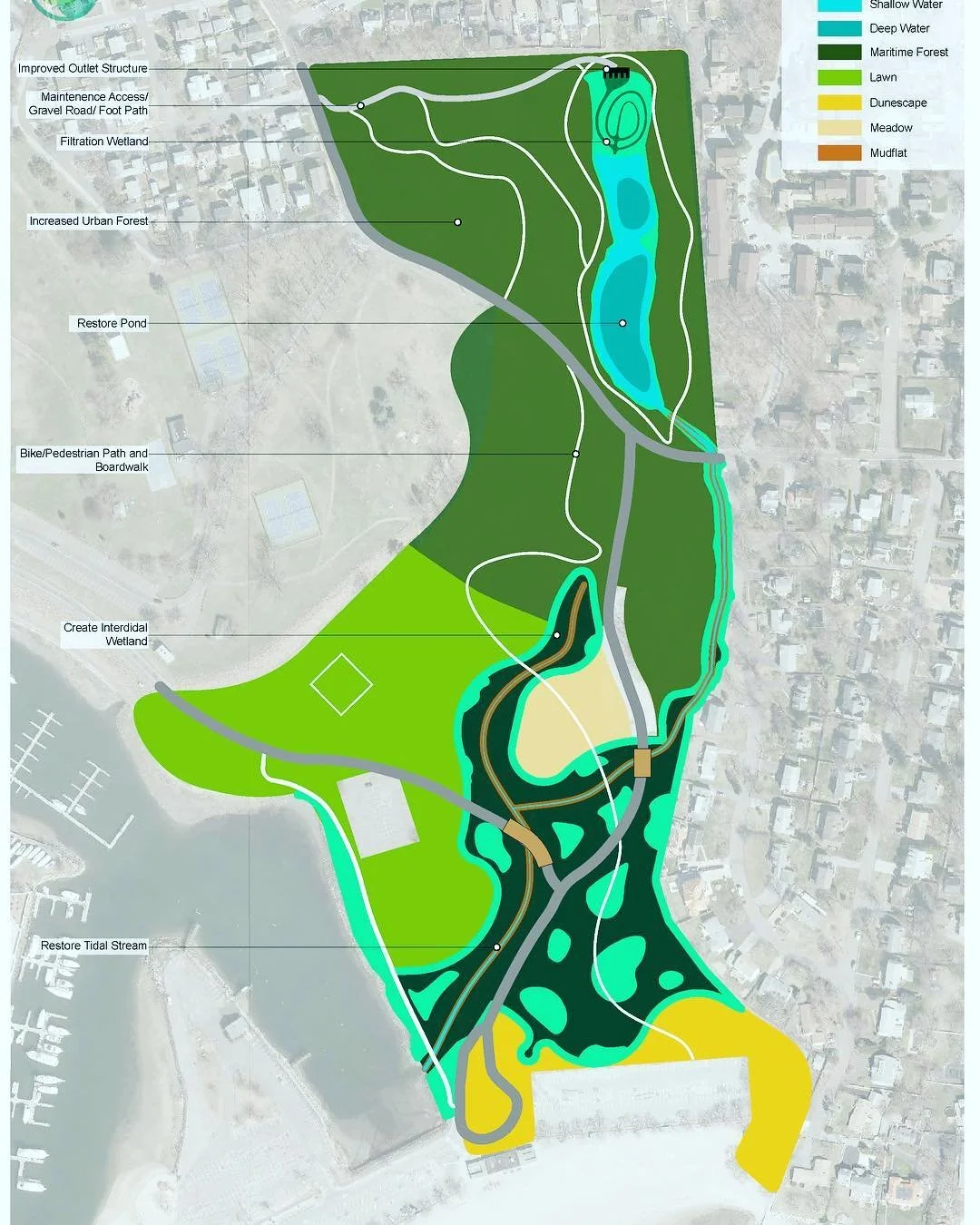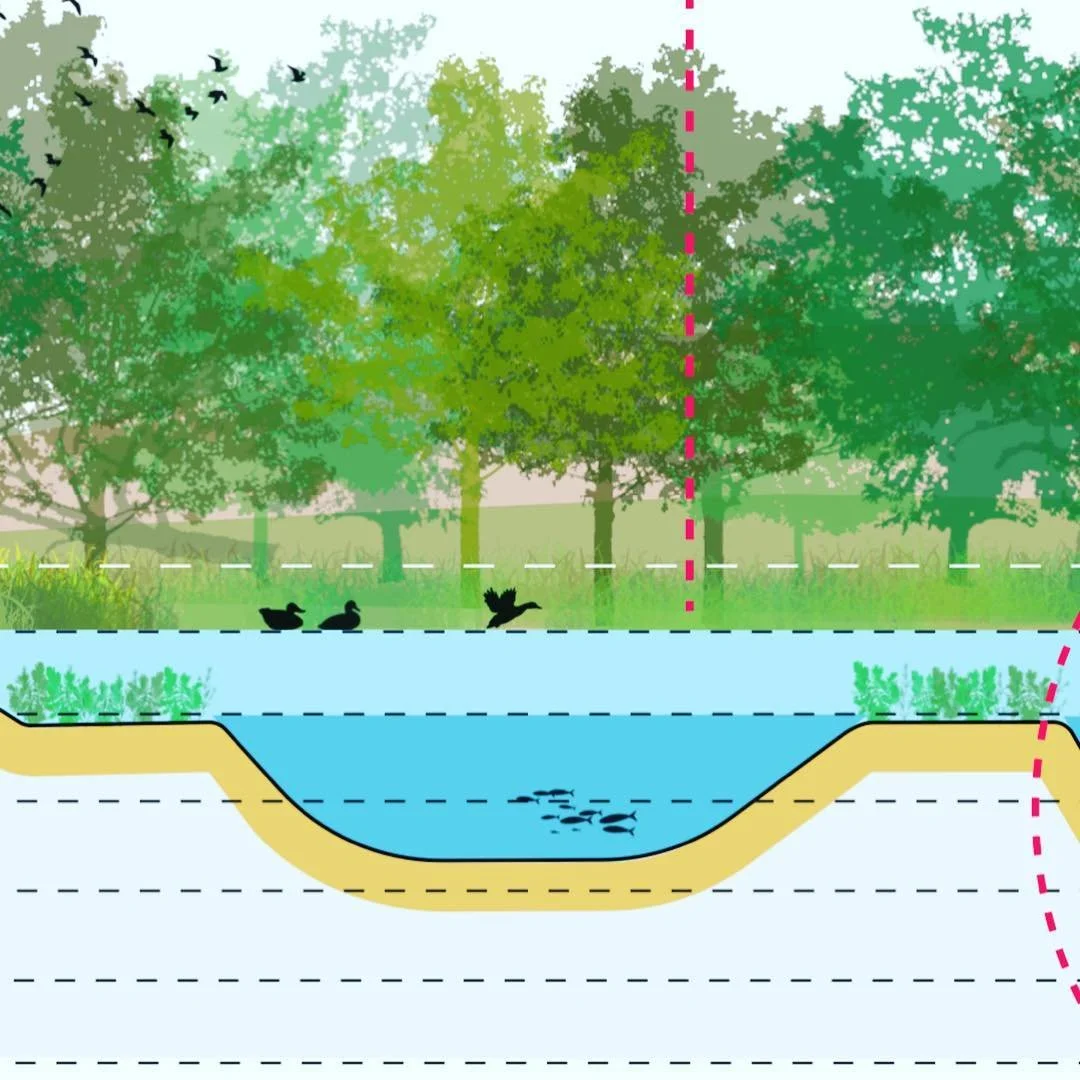Cummings Pond Restoration Plan
At One Nature, we believe that the places where people and nature meet should benefit both. When we were invited to develop a restoration plan for Cummings Pond, we saw an opportunity to make a real difference for a small ocal watershed. This wasn’t just about fixing a pond—it was about improving the health of the land, water, and community. Cummings Pond - once an important community asset- is a place that has seen decades of wear and tear from urban development, but with the right actions, it can become a vibrant, thriving ecosystem again.
Here’s how we approached this project, what we learned, and the steps we believe are necessary to bring Cummings Pond back to life.
What’s Happening at Cummings Pond
Cummings Pond, part of Cummings Park in Stamford, Connecticut, has been through many changes over the years. Once an open water body, it has gradually filled with sediment, becoming a wetland dominated by invasive plants like Phragmites (common reeds). The water quality has declined due to stormwater runoff carrying pollutants from upstream urban areas. Additionally, a tidal stream that once connected the pond to Long Island Sound was buried 20 years ago, cutting off the flow of water and nutrients that the pond needs to thrive.
These changes didn’t happen overnight. Over decades, urban development upstream added more paved surfaces, increasing stormwater runoff and pollution. The pond, once an ecological and scenic gem, has become a shadow of what it used to be. However, these issues aren’t just about the pond—they’re about the entire watershed, which stretches upstream through the city and downstream to the Long Island Sound.
Our Vision for Restoration
Restoring Cummings Pond is about more than cleaning it up. It’s about creating a healthier, more resilient system that benefits nature and the people who live nearby. To do this, we developed a plan with three main goals:
Fix Problems Upstream: The pond’s issues start with what’s happening upstream. Stormwater runoff from streets, roofs, and other paved areas brings pollution and sediment into the pond. To address this, we recommend planting more trees in urban areas to slow and absorb rainwater, installing permeable pavements to reduce runoff, and redesigning storm drains to keep trash and debris out of the water system. We also suggest encouraging residents to install rain barrels to collect and reuse rainwater.
Restore the Pond: The pond itself needs serious work. Right now, it’s shallow, silted, and overrun by invasive plants. We propose dredging the pond to create a range of water depths, which will support different types of aquatic life. We’d also add a filtration wetland at the pond’s northern end to clean the water before it flows into the pond. Around the edges, we’d plant a buffer of native trees and shrubs to provide habitat for wildlife and improve the pond’s scenic value. Finally, we want to remove the buried pipe in the southern part of the pond and let water flow naturally out to downstream areas.
Bring Back the Tidal Stream and Marsh: Downstream from the pond, the buried tidal stream and surrounding marsh are critical areas for restoration. By uncovering the stream and expanding the marsh, we can create more habitat for wildlife, improve water quality, and prepare for rising sea levels. The restored marsh would also act as a natural buffer, protecting nearby homes from storm surges.
The Challenges We Face
This is a big project, and it comes with challenges. For one, sedimentation in the pond isn’t going to stop unless we address the sources upstream. We also suspect that some of the pond’s sediment contains hazardous materials, which will need to be tested and safely removed. Sea level rise is another major factor, as it could flood parts of the park in the coming decades. Lastly, funding such a large project will require a mix of local, state, and federal support, as well as grants and partnerships.
Even with these challenges, we see them as opportunities. For example, addressing stormwater runoff upstream will not only help the pond but also improve urban green spaces and reduce flooding. Restoring the tidal stream and marsh downstream will help prepare the area for future sea level rise while creating beautiful natural spaces for people to enjoy.
How We’ll Get It Done
To make this restoration a reality, we recommend starting upstream and working downstream. Here’s how we would phase the project:
Begin with upstream fixes, like planting trees, installing permeable pavements, and redesigning storm drains. These actions will reduce sediment and pollution flowing into the pond.
Next, restore the pond itself. Dredging the pond, adding a filtration wetland, and planting native vegetation will improve its health and scenic value.
Finally, focus on the tidal stream and marsh. Daylighting the buried stream and creating more marshland will provide lasting benefits, especially as sea levels rise.
We’ll also need ongoing monitoring and community involvement to ensure the project stays on track. Restoration isn’t a one-time event—it’s a process that requires care and adaptation over time.
Why This Matters
Cummings Pond isn’t just a pond. It’s part of a larger ecosystem, and it’s a place where people come to connect with nature. Restoring the pond will bring back habitats for plants and animals, improve water quality, and create a more beautiful, functional park for the community. It will also set an example of how urban areas can work with nature, not against it.
At One Nature, we believe this project has the potential to transform not only the pond but also how the city of Stamford approaches green spaces and sustainability. This is a chance to heal a place that has been neglected for too long and to ensure it thrives for generations to come.
Restoring Cummings Pond isn’t easy, but it’s necessary. Together, with the city and the community, we can bring this vision to life. By caring for the land, we create a better future—for the pond, for the park, and for all of us who are connected to it.






